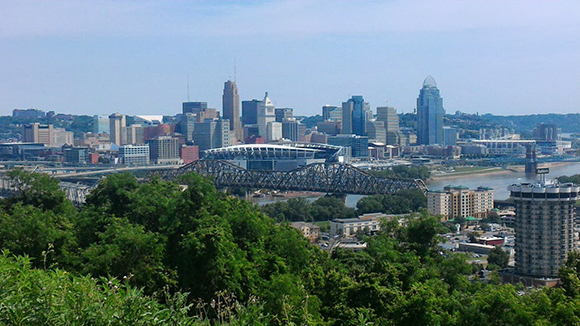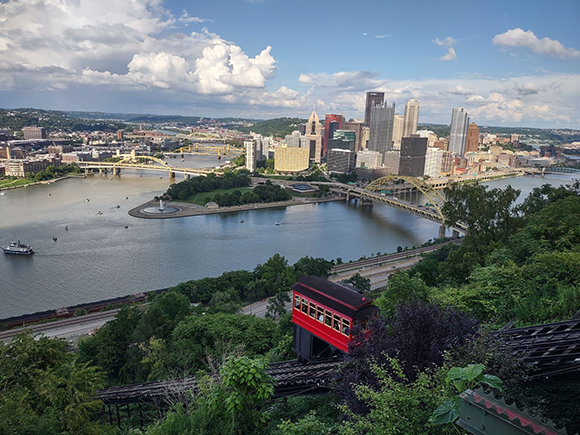Despite their cultural differences, river towns Cincinnati and Pittsburgh share good people and astounding scenery.

When I first came to Pittsburgh in January 2022, I didn’t know what to expect. Originally from the Cincinnati area, I had visited the city once, but just for a couple of days many years ago. I remembered that there were a lot of hills, and I remembered someone yelling “Big Red Machine!” at me on Boulevard of the Allies when they saw me wearing a Reds ballcap. Beyond that, I came in with a pretty open mind.
The similarities between the two cities abound. They’re both river towns abutting the Ohio River. Both cities are similar in size: the Pittsburgh metro is a bit larger but has experienced population loss in the last couple of decades while Cincinnati’s has grown in comparison (source: macrotrends.net). They both have some notable blue collar roots: Pittsburgh’s in steel and heavy industry, Cincinnati’s in food, beverage, and consumer goods production. Both are outstanding destinations for “foodies,” sports fans, and people looking for arts and culture. Both are “nexus cities” located near a convergence of different regions: Pittsburgh an Appalachian town on the edge of the Midwest and the mid-Atlantic region, Cincinnati a Midwestern town bordering the South and not far from Appalachia itself.
Something that stands out about Pittsburgh right away is its geography–its natural beauty. Driving in from the west, you have the option of approaching downtown on I-376. There’s a 2/3-mile long tunnel, the Fort Pitt Tunnel, which connects downtown to the western suburbs. It’s quite a surreal experience traveling through the dark tunnel and emerging to see the enormous expanse of downtown Pittsburgh on the other side. It’s like an artistic canvas painted with skyscrapers and two large rivers (the Allegheny and Monongahela, or “Mon”) that come together to form another (the Ohio) with large hills and bridges interspersed throughout the surrounding landscape. With over 400 bridges in the metro area–more than in Venice, Italy–Pittsburgh is often called the “City of Bridges,” in addition to its more common moniker of the “Steel City,” a nod to its history as one of the largest steel-producing towns during America’s industrial heyday.
 In photo: Duquesne Incline in Pittsburgh, PA
In photo: Duquesne Incline in Pittsburgh, PA
Like Cincinnatians, people here love an eclectic variety of food. Back home, we have Cincinnati-style chili: Skyline, Gold Star, Delhi and Price Hill Chili if you’re on the west side, and so many others. In Pittsburgh, they have Primanti Brothers, a chain of restaurants known for putting fries on their sandwiches. Back home, there’s Graeter’s Ice Cream (which, thankfully, you can buy here); in Pittsburgh, there’s Sarris Candies, including their highly celebrated chocolate. I don’t know that I’ve been to another city this size that has so many locally owned pizzerias (though, to be fair, there really isn’t a locally owned one in Pittsburgh that I know of that’s achieved the reach of LaRosa’s). The Oakland district–known for its plethora of museums, universities, and cultural offerings–features dozens of restaurants to suit just about any taste. There’s even a Little Italy in the East End neighborhood of Bloomfield replete with Italian restaurants, markets, and other businesses.
Like Cincinnati’s “Please?” (meaning, “What did you say?”), Pittsburgh has many regional sayings. A “jagger bush” is foliage with stickers on it. A “gumband” is a Western Pennsylvania saying that means rubber band. If I’m going to “redd up the place,” it means I’m going to clean or organize the house. “N’at” means “and that”—“I just wanted to see how you were doin’ n’at.” And another that you’ll hear–maybe even see on a billboard somewhere: “Yinz.” It’s a way of saying “you” or “you all.” For example, “Good morning, yinz!” or “I thought yinz guys were going to the Pens game tomorrow.” People here seem particularly proud of that one–so much so that Pittsburghers are often known as “Yinzers.” There’s even a coffee chain in town called “Yinz Coffee” (their mochas are pretty solid).
If you’ve heard that Pittsburgh folks are passionate about sports, that is completely accurate. Cincinnati folks are very passionate about sports–I myself am an ardent Reds fan (please start winning again)–but I would say that Pittsburghers take that passion to a different level. Their beloved “Stillers” (Steelers) seem almost universally celebrated, even when they’re not doing as well as in their many Super Bowl-winning years. The Penguins (or “Pens,” as they’re called) of NHL hockey have a raucous following as well. The Pirates baseball team has a good fan base, though their fans seem a bit more reserved in comparison. The University of Pittsburgh (“Pitt”) Panthers have a football program comparable in popularity to the University of Cincinnati’s, I’d say, although UC football has enjoyed greater success in recent years.
Probably the hardest part of living in Pittsburgh is dealing with the roads. Many of them, even well- traveled thoroughfares such as Fifth Avenue and Sawmill Run Boulevard, are saturated with potholes, large uneven pavement gaffes, and oddly engineered manhole coverings that cause you to wince when you don’t see one coming fast enough and feel your car’s wheel collapse into it. What’s more, there’s a noticeable contingent of Pittsburgh drivers who seem to be in a rush to get everywhere (that McDonald’s coffee can’t wait another 15 seconds) and aren’t shy about signaling their opinion. Worst yet, some will tailgate, cut you off for no apparent reason, or make the ill-advised “Pittsburgh left” (it’s on Wikipedia; look it up) at an intersection. At times it feels like “Lord of the Flies” on wheels.
Even with all of the differences–like the milder winters of Cincinnati, the more-than-subtle assertiveness of many Pittsburgh drivers, and the condition of the roads–there’s a palpable respect and connection that their people share. I thought when I came to the Steel City that there would be no love lost for Cincinnati, and that’s simply not the case. So many of these “Yinzers” like and also respect Cincinnati: Uber drivers, random people in restaurants, and neighbors in my immediate community have spoken with reverence and enthusiasm on topics ranging from the Bengals (“Burrow and Chase are exciting to watch!”) to Kings Island (“We love going there with our kids”) to downtown (“It’s so beautiful on the river”). There are warm, passionate people here who’ve built an outstanding city of cultural and economic opportunity that’s totally worth experiencing–and not just for those breathtaking riverfront views.
Photos by Jeremy Rosselot-Merritt
Jeremy Rosselot-Merritt was a communication arts major (written communication minor) who was copy editor and staff writer for “Dateline.” He is a lecturer in the Department of English's Writing and Communication program at Carnegie Mellon University in Pittsburgh, where he teaches courses in first-year writing and technical and professional writing.

